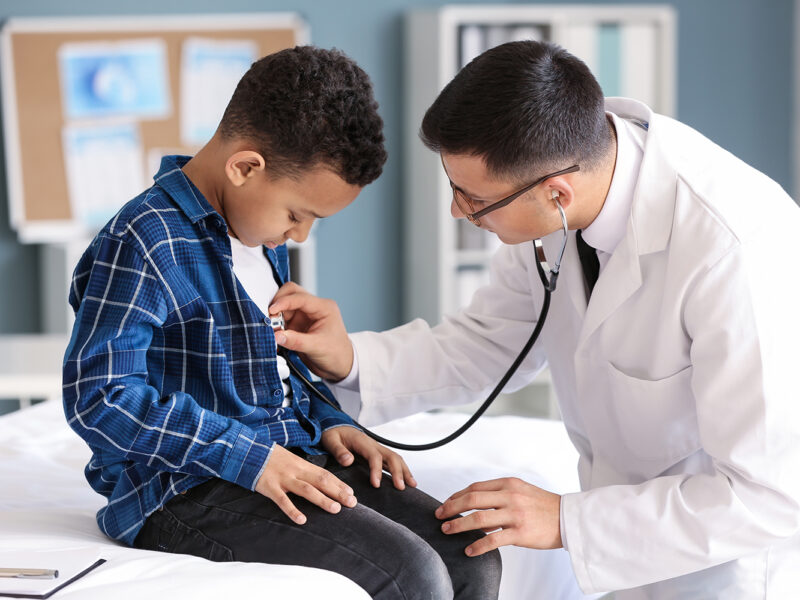Weaving an Antimicrobial Safety Net
Weaving an Antimicrobial Safety Net https://pediatricsnationwide.org/wp-content/themes/corpus/images/empty/thumbnail.jpg 150 150 Kevin Mayhood Kevin Mayhood https://secure.gravatar.com/avatar/bd57a8b155725b653da0c499ae1bf402?s=96&d=mm&r=g- April 02, 2018
- Kevin Mayhood
Stewards thread together monitoring programs and new protocols while trimming unwarranted tests and diagnostic speed.
This story also appeared in the Spring/Summer 2018 print issue. Download a PDF of the print issue.
Studies estimate that 30 to 50 percent of antimicrobials prescribed in hospitals and up to 50 percent prescribed in outpatient settings are either unnecessary or inappropriate. That’s not only wasteful but harmful, say antimicrobial stewards. Each prescription increases a patient’s risk of suffering side effects, ranging from rash and dizziness to severe allergic reaction and Clostridium difficile infection, and speeds the growth of bacterial resistance.
Bacteria inevitably become resistant to antibiotics, but the more antibiotics taken, the more certain resistant bacteria will emerge, says Josh Watson, MD, an infectious diseases physician and interim director of Antimicrobial Stewardship (AS) at Nationwide Children’s Hospital.
The Centers for Disease Control and Prevention estimate at least 23,000 Americans die each year from antibiotic-resistant infections. A report commissioned by the United Kingdom’s government suggests that if resistance is not slowed and new drugs developed, 10 million people worldwide will die annually from drug-resistant infections by 2050, surpassing the predicted number of deaths caused by cancer. Adding to the concern of antibiotic overuse, epidemiological studies suggest overexposure to antibiotics is associated with obesity, Crohn’s disease, irritable bowel syndrome and autoimmune diseases.
“We’re using antibiotics at such a high rate that we have room to decrease usage and have an impact,” says Jason Newland, MD, associate professor of Pediatrics and Infectious Diseases at Washington University and director of the Antimicrobial Stewardship Program at Washington University St. Louis Children’s Hospital.
Efforts at children’s hospitals across the United States are showing progress and creating a complex and interconnected safety net evolving to reduce antimicrobial misuse. In addition to monitoring prescriptions, threads include a simple protocol to halt children from taking unneeded drugs, eliminating unnecessary testing that can lead to unneeded drug prescription, and more rapid and accurate diagnostics. Screening and testing children labeled allergic to penicillin is another. Ninety percent of them are not allergic and would likely benefit from effective narrow-spectrum antibiotics from the penicillin family.
“What we’ve seen for children’s hospitals that have implemented an effective AS program is that it has core elements reflective of the CDC publication on AS,” says Dr. Newland, who has studied AS programs across the country. “Administrative support is a must. A dedicated pharmacist — a full-time equivalent dedicated to AS — is very valuable. You need a physician leader who’s in the trenches with them and that requires dedicated time and financial support to perform AS. We’ve seen that programs with financial support have a greater decrease in improper antimicrobial use than those without financial support.”
And, accepted practices must be changed or at least fine-tuned, he and other stewards say.
The more antibiotics taken, the more certain resistant bacterial will emerge.
— Josh Watson, MD, interim director of Antimicrobial Stewardship at Nationwide Children’s Hospital

DAILY ROUNDS
“Hospitals and doctor’s offices have traditionally used broad and powerful antibiotics ‘just in case,’ but it’s likely we’re doing harm with that strategy,” says Sarah Parker, MD, a pediatric infectious disease physician and medical director of the Antimicrobial Stewardship Program at Children’s Hospital Colorado.
Dr. Parker carries the CDC’s message that each patient should receive “the right antibiotic, in the right dose, at the right time, for the right duration,” to the hospital’s health faculty daily.
The face-to-face AS program she and colleagues have developed, called handshake stewardship, cuts misuse of antibiotics while cutting costs. The program reduced antimicrobial use by 10 percent during its first four years. The savings amount to more than $1 million annually, she says.
While some AS programs require hospital faculty to get prior approval for a prescription and others review only a sample of prescriptions, under handshake stewardship Dr. Parker and a pharmacist review every antibacterial, antifungal and antiviral prescribed at the hospital and available lab information at 24 and 72 hours. They then make daily rounds and ask questions about a list of patients that caught their attention and may make suggestions for more conservative options. Even if they don’t have questions, the team talks with prescribers every day.
“This fosters better exchange,” says Dr. Parker, who is also an associate professor of Pediatrics and Infectious Diseases at the University of Colorado School of Medicine. “Providers like it a lot more; they say they don’t feel as policed.”
Within the 10 percent overall decrease in antimicrobial usage the program has achieved, use of the broad-spectrum antibiotic vancomycin was reduced 26 percent and broad-spectrum meropenem 22 percent. A preliminary review of numbers through 2017 shows the hospital sustained the cuts and may have actually further reduced usage in some areas, Dr. Parker says.
Some programs review usage of only certain antibiotics, but Children’s Colorado looks at all.
“We improved use of simple antibiotics,” Dr. Parker says. “We found that amoxicillin was misprescribed a lot in the hospital. It was a great opportunity to teach. Prescribers then applied what they learned to more sophisticated antibiotics.”
The rounds are a two-way street, Dr. Parker says, helping her understand what faculty in different departments face daily and enabling her to better help them with stewardship. The program has also helped spur collaborations among physicians, who produced studies to determine the most appropriate antibiotics for appendicitis and musculoskeletal infections.

Hospitals and doctor’s offices have traditionally used broad and powerful antibiotics ‘just in case,’ but it’s likely we’re doing harm with that strategy.
— Sarah Parker, MD, medical director of the Antimicrobial Stewardship Program at Children’s Hospital Colorado
OUTPATIENTS, TOO
Most stewardship programs began by focusing on patients who stay at the hospital, but physician-researchers at Nationwide Children’s have found the need is also clear in outpatient settings.
Dr. Watson and Terry Barber, MD, medical director of Nationwide Children’s offsite Urgent Care Centers, noticed urgent care physicians were prescribing antibiotics for a high number of children who had symptoms of a urinary tract infection (UTI) but whose urine culture, returned a few days later, was negative for infection. Dr. Watson and colleagues came up with a simple protocol to follow-up with a child’s caregiver. When urinalysis is negative and a clinician determines the antibiotic is unnecessary, a nurse calls the caregiver to stop giving the drug to the child. If phone calls fail to reach the caregiver on two consecutive days, the nurse sends a letter to discontinue taking the medicine.
“It ended up being pretty smooth sailing,” Dr. Watson says. “The urgent care doctors and nurses embraced it right away.”
A study found that prior to implementation of the protocol, follow-ups to discontinue usage were documented in 4 percent of cases. That grew to 84 percent of cases.
The protocol initially cut the number of days children were taking unnecessary antibiotics by 40 percent. As staff became accustomed to the steps and a lab nurse was designated to follow up with families, the number grew to 60 percent.
Nationwide Children’s Emergency Department has since adopted the program. There, Dr. Watson and another team had found the same pattern. Only 55 percent of children prescribed antibiotics for UTI had positive cultures.
Their goal is to make the protocol a standard routine as quickly as possible and at least match the reduction in unnecessary antibiotic exposure they’ve achieved in the urgent care centers.
DIAGNOSTIC STEWARDSHIP
“We need better diagnostic tools, and we need to do better with the tools we have currently,” says Dr. Watson, who is also an assistant professor of Pediatrics at The Ohio State University College of Medicine.
Dr. Watson’s teams are pursuing diagnostic stewardship to further reduce antibiotic usage, risk to children and costs.
He and colleagues are investigating whether antimicrobial peptides (AMPs) found in urine can be used as biomarkers of UTIs. Their initial study found that the AMPs HD5 and HNP1-3 appear to improve the specificity without decreasing the sensitivity of the UTI test. The researchers believe a combination of biomarkers will lead to tests that produce fewer false-positive results, and thereby reduce unnecessary antibiotic exposure. They and urgent care physicians also are investigating how to identify children who can wait for results of a urine culture and start an antibiotic only if an infection is confirmed.
“Diagnostic stewardship also requires we order tests appropriately,” says Preeti Jaggi, MD, an infectious disease specialist and former director of AS at Nationwide Children’s who is now medical director of Stewardship and Optimization of Antimicrobial Prescribing at Children’s Healthcare of Atlanta.
At Nationwide Children’s, she and Dipanwita Saha, MD, director of Quality Improvements in Urgent Care at Nationwide Children’s and assistant professor of Pediatrics at Ohio State, found that the hospital’s centers were swabbing the throats of nearly 2,300 children per month and 74 percent of the tests were coming back negative for streptococcal pharyngitis.
“Clearly, we’re swabbing too many,” Dr. Saha says. And among those with a positive result were children who received but didn’t need an antibiotic, Dr. Jaggi says. “Twenty percent of kids carry group A streptococcus that causes them no harm.”
To tackle overswabbing and overprescription of antibiotics, Drs. Saha and Jaggi refined the Licensed Provider Initiated Protocol used hospital-wide to guide when to swab. They spelled out symptoms of strep infection and said children with a sore throat and one or more of the symptoms should be swabbed. But, children who have a sore throat or one or more specific symptoms indicating a viral infection should not be swabbed, the revised protocol says.
With the changes in procedures, throat swabs in the urgent care centers dropped 39 percent, from 294 per 1,000 encounters to 180.
Dr. Saha plans to submit a study of the refined protocol for publication later this year.
Not all physicians have been overswabbing.
In fact, reviewing medical claims records of children in 34 Ohio counties served by Nationwide Children’s accountable care organization, Partners For Kids, Drs. Watson and Jaggi found that some pediatricians and general practice physicians in the community are swabbing too few children.
“Children are being treated for streptococcal pharyngitis without a confirmatory test,” Dr. Watson says. “It seems that depending on the setting of care, either overtesting or undertesting can contribute to overuse of antibiotics.”

SPEEDING STEWARDSHIP
As diagnostics become more sophisticated, stewardship should be involved in implementing them, Dr. Parker says.
In a recent study, researchers at Children’s Colorado found that use of a commercially available rapid blood culture identification system (BCID) and rapid AS reduced the median time to optimal antimicrobial therapy from 60 hours to just under 27 hours. Using a BCID, hospital staff identified the organism infecting a child’s bloodstream in about an hour instead of the day or two traditional microbiology techniques require. Stewards reviewed and relayed the results and recommended the appropriate antimicrobial to the health care provider within 20 minutes.
Because resistance mechanisms vary among species, knowing the organism often allows the provider to use immediately a more targeted antibiotic instead of a broad-spectrum drug.
“When we receive results of susceptibilities tests a day or two later, we get the child on a narrower antibiotic,” Dr. Parker says.
“But people were still inclined to wait for the old way before prescribing a new antibiotic,” Dr. Parker says. “We had to educate them. If we hadn’t, we don’t think there would have been uptake of the rapid system and we wouldn’t have created change.”
For children who were diagnosed with the BCID, the mean duration of antimicrobial therapy was 367 hours compared to 475 hours for a control group that had been diagnosed using traditional techniques. Unnecessary antibiotic initiation for children with a culture containing organisms considered contaminants and not infections decreased from 76 percent to 26 percent.
Use of a BCID to distinguish likely contaminants from infection has also reduced hospital admissions at Nationwide Children’s, says Dr. Watson.
In the past, when a culture was positive and a Gram stain showed Grampositive cocci, the child would be called back, admitted and placed on antibiotics until the bacterium was identified. Now, if the BCID identifies a common contaminant, staff will call and check on the patient, he says.
Most people who get labeled with a penicillin allergy as a kid were taking amoxicillin or penicillin when they had a viral infection. They got a viral rash and were told that it was an allergic reaction to the medication. From then on, they are told to avoid penicillin and related antibiotics.
— Mitchell Grayson, MD, director of the Division of Allergy and Immunology at Nationwide Children’s

OVER-LABELING ALLERGIES
Another way hospitals are trying to get children on the optimal drug is by screening and testing children for penicillin allergy.
“Beta-lactam antibiotics, including penicillin, are among the cheapest and most effective,” says Mitchell Grayson, MD, director of the Division of Allergy and Immunology at Nationwide Children’s. “If you can tell who’s truly allergic, it improves the ability to use the right drug.”
He points to studies that have shown that as many as 10 percent of people are labeled as allergic to penicillin, but of those 10 percent labeled as “allergic,” more than 90 percent can still tolerate penicillin and are indeed not allergic to penicillin.
“Most people who get labeled with a penicillin allergy as a kid were taking amoxicillin or penicillin when they had a viral infection. They got a viral rash and were told that it was an allergic reaction to the medication,” Dr. Grayson says. “From then on, they are told to avoid penicillin and related antibiotics.”
And that has costs. Eric Macy, MD, an allergy, asthma and immunology physician with Kaiser Permanente in San Diego, found that adults with a penicillin allergy history had longer hospital stays and more C. difficile, methicillin-resistant Staphylococcus aureus and vancomycin-resistant Enterococcus infections.
The financial costs to patients and the health care system are up to 63 percent higher because these patients are treated with more expensive antibiotics, including fluoroquinolones, clindamycin and vancomycin, and have more complications.
Dr. Grayson and colleagues in Allergy and Immunology at Nationwide Children’s have been evaluating and testing children labeled as penicillin allergic for years, and they have found almost none has a true penicillin allergy.
The specialists are preparing a penicillin allergy information handout and decision tree, based partly on their screening experience. The tree asks physicians to consider the type or types of reactions the child has had after taking a beta-lactam, the timing of the reaction and when to consider referring a child for penicillin testing. Dr. Grayson suggests general pediatricians and practitioners in particular should have the information.
“The time to know whether children are allergic to penicillin is before they have an infection and need an antibiotic,” he says.
ADDING THREADS
Stewards are continuing to find ways to reduce antimicrobial usage.
Drs. Watson and members of his AS team are using the Partners For Kids data to analyze antimicrobial prescribing for a number of conditions and diseases diagnosed and plan to give feedback to providers to help curb overprescription. The data, like the CDC’s, shows more overprescribing in rural communities.
Other institutions are now implementing handshake stewardship or aspects of the program. Dr. Parker suggests that AS can also be paired with a variety of rapid diagnosis technologies becoming available to get children on the appropriate medicine sooner.
“We definitely must have more urgency,” Dr. Newland says. “In the last few years, the CDC, World Health Organization and the United Nations have made this a priority, but we need to do better reaching out to society. As doctors, we have to address this.”
The costs of doing otherwise are too high, Dr. Jaggi says:
“The effect of inappropriate exposure to antibiotics lasts a lifetime.”
References:
- Barlam TF, Cosgrove SE, Abbo LM, MacDougall C, Schuetz AN, Septimus EJ, Srinivasan A, Dellit TH, Falck-Ytter YT, Fishman NO, Hamilton CW, Jenkins TC, Lipsett PA, Malani PN, May LS, Moran GJ, Neuhauser MM, Newland JG, Ohl CA, Samore MH, Seo SK, Trivedi KK. Implementing an antibiotic stewardship program: Guidelines by the Infectious Diseases Society of America and the Society for Healthcare Epidemiology of America. Clinical Infectious Diseases. 2016 May 15;62(10):e51-77.
- Hurst AL, Child J, Pearce K, Palmer C, Todd JK, Parker SK. Handshake stewardship: A highly effective rounding-based antimicrobial optimization service. The Pediatric Infectious Disease Journal 2016 Oct;35(10):1104-10.
- Messacar K, Hurst AL, Child J, Campbell K, Palmer C, Hamilton S, Dowell E, Robinson C, Parker SK, Dominguez SR. Clinical impact and provider acceptability of real-time antimicrobial stewardship decision support for rapid diagnostics in children with positive blood culture results. Journal of the Pediatric Infectious Disease Society. 2017 Sep 1;6(3):267-274.
- Mistry RK, Newland JG, Gerber JS, Hersh AL, May L, Perman SM, Kupperman N, Dayan PS. Current state of antimicrobial stewardship in children’s hospital emergency departments. Infection Control and Hospital Epidemiology. 2017 Apr;38(4):469-475.
- Saha D, Patel J, Buckingham D, Thornton D, Barber T, Watson JR. Urine culture follow-up and antimicrobial stewardship in a pediatric urgent care network. Pediatrics. 2017 Apr;139(4) pii: e20162103.
- Watson JR, Hains DS, Cohen DM, Spencer JD, Kline JM, Yin H, Schwaderer AL. Evaluation of novel urinary tract infection biomarkers in children. Pediatric Research. 2016 Jun;79(6):934-9.
- Vyles D, Adams J, Chiu A, Simpson P, Nimmer M, Brousseau DC. Allergy testing in children with low-risk penicillin allergy symptoms. Pediatrics. 2017 Aug;140(2) pii: e20170471.
- Macy E, Contreras R. Health care use and serious allergy infection prevalence associated with penicillin “allergy” in hospitalized patients: A cohort study. The Journal of Allergy and Clinical Immunology. 2014 Mar;133(3):790-6.
Image credits: Nationwide Children’s (graphic; portraits of Dr. Grayson and Dr. Watson); Children’s Hospital Colorado (portrait of Dr. Parker)
About the author
-
Kevin Mayhoodhttps://pediatricsnationwide.org/author/kevin-mayhood/
-
Kevin Mayhoodhttps://pediatricsnationwide.org/author/kevin-mayhood/April 25, 2015
-
Kevin Mayhoodhttps://pediatricsnationwide.org/author/kevin-mayhood/April 25, 2015
-
Kevin Mayhoodhttps://pediatricsnationwide.org/author/kevin-mayhood/April 25, 2015
- Posted In:
- Features







